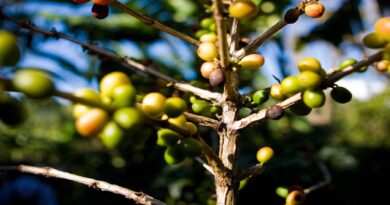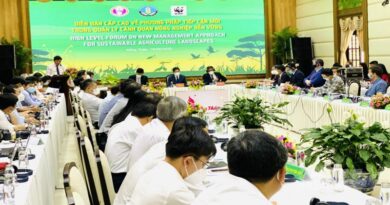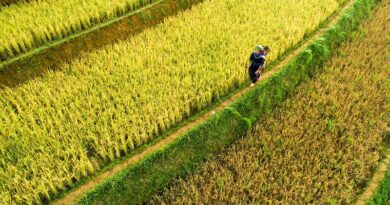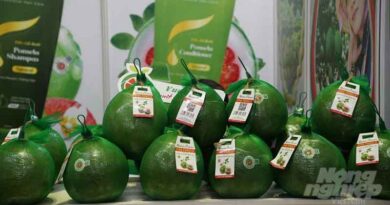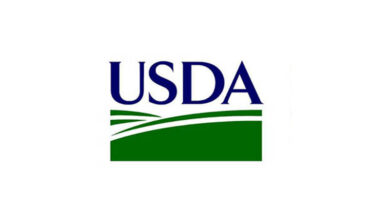Vietnam’s Growing Presence in the Global Agriculture Market: Lessons for India
By Nimish Gangrade, Editor, Global Agriculture (The article was originally published in Global Agriculture)
01 July 2024, New Delhi: Vietnam’s agricultural sector is experiencing remarkable growth, positioning the country as a key player in the global agriculture market. As Vietnam gains visibility on the international stage, it offers valuable lessons for other countries, particularly India, on how to capitalize on the opportunities in the agriculture sector. To understand the success of Vietnam’s agriculture, it is necessary to understand its agricultural exports, funding development in agriculture, drivers of sector development, barriers faced, foreign investment, and the future prospects of Vietnam’s agricultural products.
Vietnam’s Agricultural Exports
In 2022, Vietnam witnessed significant growth in its agricultural sector, with a growth rate of 3.36 percent. The farming sub-sector experienced a growth rate of 2.88 percent, fisheries grew by 4.43 percent, and forestry increased by 6.13 percent. The export turnover of the entire industry exceeded US$53.22 billion.
Vietnam’s agricultural products are exported worldwide, with key exports including walnuts, coffee, and rice. These three products alone accounted for over US$5.7 billion worth of agricultural exports in 2021. Other notable agricultural exports include pepper, natural rubber, fruits, vegetables, and pastries. Vietnam’s agricultural exports demonstrate its capacity to meet global demand and establish a strong presence in the international market.
Top 10 Vietnamese Agricultural Exports in 2021
| S. No | Description | Value (US$1,000) |
| 1 | Walnuts, shelled | 34,39,931 |
| 2 | Coffee, green | 23,27,922 |
| 3 | Rice, milled | 20,69,836 |
| 4 | Pepper (Piper spp.), raw | 18,18,418 |
| 5 | Natural rubber in other forms | 10,36,537 |
| 6 | Other fruits, n.e.c. | 7,77,974 |
| 7 | Fruit prepared n.e.c. | 6,06,425 |
| 8 | Coffee extracts | 4,09,362 |
| 9 | Other vegetables, fresh n.e.c. | 2,46,598 |
| 10 | Pastry | 2,23,451 |
Funding Development in Agriculture in Vietnam
Overseas direct assistance (ODA) has played a crucial role in Vietnam’s agricultural growth, complemented by the support of the Ministry of Agriculture and Rural Development (MARD). By the end of 2022, MARD had approved four ODA projects and investment policies with a total loan value of US$840 million. Additionally, the ministry collaborated with businesses to prepare 14 new project proposals, requiring a total capital of US$3.2 billion.
In the previous year, the agricultural sector mobilized US$300 million in grant aid and approved 15 projects worth US$25 million for non-governmental organizations. Furthermore, Vietnam attracted significant foreign direct investment (FDI) in agriculture, with 12 new projects and US$68 million in newly registered capital. Despite these investments, there is still a need for additional capital to facilitate the sector’s continued development.
Drivers of Agricultural Sector Development: Government Incentive and FTA
The Vietnamese government has implemented various incentives and support mechanisms to drive investment in the agriculture sector. Decree No.57/2018/ND-CP serves as the foundation for these policies, aiming to attract investment into agricultural and rural development. The incentives outlined in the decree include fee exemptions, waivers of land rental payments, interest rate subsidies on commercial loans, and government funding for essential facilities.
Vietnam has also actively pursued free trade agreements (FTAs) to expand its market access. The country is a party to 15 FTAs, including the EU-Vietnam Free Trade Agreement (EVFTA) and the Comprehensive and Progressive Agreement for Trans-Pacific Partnership (CPTPP). These agreements have opened up new markets for Vietnamese agricultural products, such as South Korea and the European Union, providing opportunities for increased exports.
Agricultural Development Barriers in Vietnam
While FTAs present opportunities, they also introduce challenges for Vietnam’s agricultural sector. The incomplete quality standards system for Vietnamese agricultural products can hinder their acceptance in foreign markets. Furthermore, the elimination or reduction of import tariffs through FTAs exposes the domestic market to competition from other major agricultural producers, such as Australia, New Zealand, and Canada. This can place domestic producers at a disadvantage if they cannot compete with international players in terms of financing and technology.
Climate change poses another significant challenge for Vietnam’s agricultural sector. The country is highly vulnerable to the adverse impacts of climate change, including droughts, floods, and saltwater intrusion. Adapting to these changes requires substantial investments in modified farming techniques and new technologies. Vietnamese firms are already investing millions of dollars in advanced farming technology to increase efficiency and reduce the environmental footprint of agriculture. Collaboration with foreign institutions and startups that offer agricultural education programs, training, and technology know-how can enhance Vietnam’s sector capability and human capital.
A Lack of Skilled Labor
Vietnam’s agricultural sector is confronted with a shortage of highly skilled labor. As the workforce increasingly moves towards secondary and tertiary sectors, such as manufacturing and services, the availability of skilled agricultural workers diminishes. The aging workforce within the sector often lacks technical skills beyond traditional farming methods and technological literacy. This hampers the adoption of modern farming techniques.
However, the shortage of skilled labor can be viewed as an opportunity for foreign collaboration and investment in education. Emerging and developed countries that offer advanced agricultural education programs, training, and technology expertise can contribute to upgrading Vietnam’s sector capability and human capital. Vietnam’s ongoing efforts to expand its education sector and promote international cooperation can lead to positive outcomes for both Vietnam and foreign investors.
Foreign Investment in Vietnamese Farms
Foreign investment in plant-based agriculture in Vietnam does not carry any specific conditions. Foreign companies looking to invest in agriculture must comply with standard investment, enterprise, and company laws. However, the 2013 Land Lawin Vietnam restricts foreign ownership of land, which can be a barrier for foreign investors interested in acquiring land for agricultural purposes. To overcome this challenge, foreign investors often enter into joint ventures or lease land from local farmers or agricultural enterprises.
Foreign investment in Vietnam’s agriculture sector primarily focuses on high-tech agriculture, aquaculture, livestock, and agricultural processing. Singapore, Japan, South Korea, and the Netherlands are among the major investors in Vietnam’s agriculture sector. These countries bring advanced technologies, management expertise, and financial resources to enhance productivity and value addition in the sector.
Future Prospects for Vietnam’s Agricultural Products
Vietnam’s agriculture sector has significant growth potential and favorable prospects for the future. As the global demand for high-quality and sustainable agricultural products increases, Vietnam can leverage its competitive advantages, such as favorable climatic conditions, abundant labor force, and diverse agricultural resources.
Moreover, the ongoing digital transformation and adoption of advanced technologies in agriculture can further enhance productivity, reduce post-harvest losses, and improve the quality of Vietnamese agricultural products. Smart farming techniques, precision agriculture, and digital platforms for agricultural trading and supply chain management are gaining traction in Vietnam.
Additionally, Vietnam’s participation in regional and global trade agreements provides access to larger markets and opportunities for export expansion. By complying with international quality and safety standards, Vietnam can strengthen its reputation as a reliable supplier of agricultural products.
Lessons for India
India can draw several lessons from Vietnam’s experience in the agriculture sector:
- Infrastructure Investment: India should prioritize investment in rural infrastructure, including irrigation systems, cold storage facilities, and transportation networks. This will improve the efficiency of agricultural value chains and reduce post-harvest losses.
- Research and Development: Increased investment in agricultural research and development can drive innovation, enhance productivity, and promote sustainable farming practices. Collaborations between research institutions, universities, and private enterprises can facilitate technology transfer and knowledge exchange.
- Market Diversification: India should focus on diversifying its export markets for agricultural products. Exploring and capitalizing on regional and global trade agreements can unlock new opportunities for Indian farmers and agribusinesses.
- Technology Adoption: Embracing digital technologies and precision farming techniques can improve productivity, optimize resource utilization, and enable data-driven decision-making in Indian agriculture.
- Skilling and Education: India should prioritize agricultural education and skill development to equip farmers and agricultural workers with modern farming techniques, technology literacy, and entrepreneurial skills.
- Public-Private Partnerships: Collaboration between the government, private sector, and international organizations can foster investment, technology transfer, and knowledge sharing in the agriculture sector. Public-private partnerships can leverage the strengths of each stakeholder and drive sectoral growth.
By focusing on infrastructure development, research and development, market diversification, technology adoption, skilling and education, and public-private partnerships, India can unlock its agricultural potential and position itself as a competitive player in the global agriculture market.
The government should implement policy reforms that create a conducive environment for agricultural growth. This includes addressing issues related to crop diversification, providing farmers with the understanding of demand and supply gaps, exposing farmers to export opportunities and ensuring subsidies and grants reach the right farmers and on time. The government should also focus on simplifying and streamlining regulations, reducing bureaucracy, and ensuring policy consistency to attract investment and promote agricultural development.
(For Latest Agriculture News & Updates, follow Krishak Jagat on Google News)
(+80 Million Farming Audience Visits Krishak Jagat’s Hindi Website – Click Here for Website)



